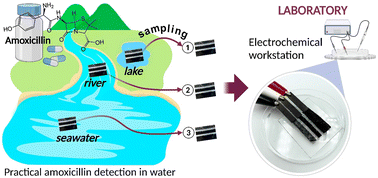A green cellulose nanofiber-based printed electrode for practical highly sensitive amoxicillin detection†
Abstract
Simple electrochemical detection of the antibiotic amoxicillin (AMX) in water is crucial to mitigate health and environmental risks; however, the process requires single-use electrodes, which can increase the waste generated as well as the cost. Cellulose nanofibers (CNFs) are biodegradable materials that can be used as electrode frameworks. In this study, a sensitive single-use CNF-based printed electrode modified with polybenzimidazole (PBI)-wrapped multi-walled carbon nanotubes (MWCNTs) is developed for AMX detection. The CNF-based printed electrode achieved a detection limit of 0.3 μM and exhibited a wider detection range of 0.3–500 μM compared with electrodes developed in previous studies. In addition, the electrode reactions of AMX were electrochemically investigated and found to primarily involve the adsorbed species at low AMX concentrations and be diffusion-controlled at high AMX concentrations. Finally, the printed electrodes were used for the easy and practical determination of AMX in seawater and tap water by a soaking method. Satisfactory results were obtained, and the final concentrations of AMX were determined using simple calibration equations. Therefore, this CNF-based electrode exhibits great potential for practical real-time AMX detection in the field.



 Please wait while we load your content...
Please wait while we load your content...